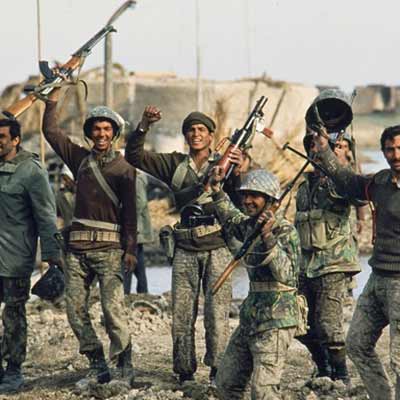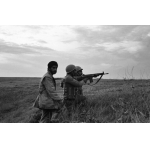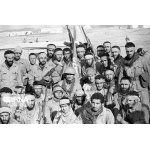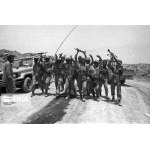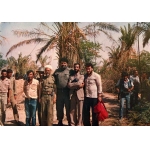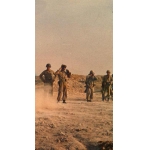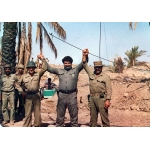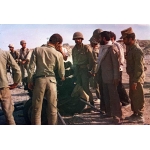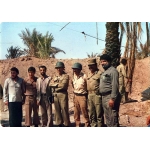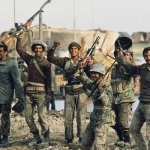Operation Thamen al-Aemmah (as)
Leila Heidari Bateni
302 بازدید
Thamen al-Aemmah (as) was the first joint operation carried out by the Islamic Republic of Iran Army and the Islamic Revolutionary Guard Corps (IRGC) during the Iran-Iraq War. It was executed mainly by the 77th Khorasan Infantry Division on September 27, 1981, on the Abadan-East Karun axis in the Khuzestan Province. The objective of this operation was to break the siege of Abadan, which was successfully achieved.
The dismissal of Bani-Sadr from the position of Commander-in-Chief of the Iranian Armed Forces facilitated the cooperation between the IRGC and the Army. Following the fall of Khorramshahr, the Baathist army besieged Abadan on November 1, 1980, by constructing a bridge over the Bahmanshir River in the Zolfaqari area north of Abadan.[1] Four days later, Imam Khomeini issued the command: “The siege of Abadan must be broken”.[2]
In late March of 1981, the Arvand Command Headquarters deployed the 77th Khorasan Infantry Division of the Army to the south to carry out operations in Khorramshahr and Abadan.[3] Consequently, an 18-kilometer road was constructed in the area to facilitate the division’s access to Abadan.[4]
The 77th Division successfully carried out limited operations such as Madan Hills or Abadan on May 15, 1981, and Darkhovein on June 11, 1981, restoring the morale of the combat forces. After suffering defeats in these operations, the Baathist army adopted a defensive tactic, retreating from East Karun and focusing on fortifying its positions within a limited area.[5]
In June of 1981, the Army Ground Forces Headquarters prepared an offensive, and assigning its execution to the 77th Khorasan Division.[6] Initially, the operation to break the siege of Abadan was named Hamzeh,[7] but the final plan was approved on September 17, 1981, under the name Operation Thamen al-Aemmah (as).[8]
One of the primary objectives of the operation was to keep the troop’s morale high. Therefore, it was planned to be launched on the anniversary of the Baathist army’s invasion of Iran, on September 22, 1981. However, ammunition shortages and enemy preparedness led to the operation being postponed for one week.[9]
The combat strength of the 77th Infantry Division consisted of three brigades, including nine infantry battalions, two tank battalions, one armored cavalry battalion, and artillery and engineering battalions. In addition, one tank battalion from the Armored Center, one tank battalion from the 16th Armored Division of Qazvin, one gendarmerie support battalion, one tank battalion from the 92nd Armored Division, and the 107th Gendarmerie Battalion stationed in the Abadan-Mahshahr area were placed under the command of the 77th Division. Also, the IRGC combat strength consisted of fifteen battalions.[10]
On September 27, 1981, at 1:00 AM, the order to launch the operation was given with the code-name “Nasru min Allah wa Fathun Qareeb (help from Allah and a victory near at hand)”. It started from three main axes under the command of Hassan Baqeri in the Darkhovein, Seyyed Yahya Rahim Safavi in the Fayyaziyeh, and Ali Asakereh in the Abadan-Mahshahr Road axis,[11] along with one secondary one.[12]
During the early hours of September 27, Battalion 136 of Brigade 1 of the 77th Division attacked the Iraqi army’s defensive positions at the Abadan-Mahshahr Road from Zolfaqariyeh. Meanwhile, Battalion 163 advanced towards the enemy’s defensive lines near the Abadan-Ahvaz Road but faced heavy artillery fire. Subsequently, Brigade 2 and Brigade 3 advanced into Fayyaziyeh and Darkhovin fronts both of which were key axes of the operation. As a result, they inflicted heavy losses on the Iraqi army and captured 122 enemy soldiers. Furthermore, Battalion 163 captured two entire Iraqi battalions, achieving the operation’s objectives.
The capture of Mared Village and Qasbah Bridge, and the Iranian forces advancing towards Haffar Bridge endangered the Iraqi troops positioned in East Karun.
The Iranian forces set the Karun River on fire to cut the connection between East and West Karun in the area between the Qasbah and Haffar bridges.[13] Consequently, the forces from the Fayyaziyeh and Darkhovin axes linked up, forming a defensive line in East Karun and surrounding the Iraqi troops. As a result, thirty Iraqi tanks, along with their commander, surrendered. In the meantime, Battalions 163 and 122 of Brigade 2 continued advancing towards the north to clear the area[14] where the temperature was about 42 °C. [15]
The Iranian forces crossed minefields and explosive traps, catching the Baathist army off guard.[16] In less than 24 hours, forces in the Darkhovin axis outflanked the enemy from the Shadegan. While those in Fayyaziyeh broke through enemy defensive lines, linking the two axes. When the Iranians took complete control of Qasbah and Haffar bridges the Iraqi forces were encircled. On the first day of the operation, numerous Iraqis were captured, the designated areas were seized, and much of the offensive capability of the Iraq 3rd Armored Division was destroyed.[17]
On the second day of Operation Thamen al-Aemmah (as), September 28, 1981, commanders ordered the bombing of an Iraqi ammunition depot in Eastern Haffar. By the end of the day, East Karun was fully under Iranian control, and the units focused on clearing the area and organizing the captives. The Iranian forces destroyed all key supply bridges, including Haffar Eastern Bridge and Qasbah Western Bridge, which had strategical importance for the Iraqi army’s western flank. The operation ended after two days with all objectives achieved. During this battle, Major Parviz Hebrani, the commander of Battalion 110 of the 77th Infantry Division, was martyred.[18]
Operation Thamen al-Aemmah (as) was a turning point in the Iran-Iraq War. It marked the end of limited battles, initiated a strategic shift in the first year of the war, and became the first step towards launching large-scale operations for the liberation of occupied territories.[19]
During this operation, the Islamic Republic of Iran Army Aviation (Havanirouz) pilots flew 40 helicopters for a total of 1,200 hours, transporting 620 wounded soldiers, evacuating 800 troops, and delivering 35 tons of supplies and ammunition.[20] The operation resulted in the liberation of over 150 square kilometers of Iranian land. In addition to its psychological and morale-boosting impact, it inflicted significant casualties on the Iraqi forces. The Iraqi commanders also admitted defeat, describing it as a ‘tactical withdrawal’.[21]
Other achievements of the operation included the clearing of areas between Mard, Soleimaniya, and the southern axis of Mahshahr and Abadan, the liberation of two important roads—Mahshahr-Abadan and Ahvaz-Abadan—and the capture of three enemy supply bridges over the Karun River.[22]
During this operation, approximately 1,800 Iraqi troops were killed or wounded, and 1,500 soldiers were captured. The Iranian forces also destroyed 90 tanks and Armored Personnel Carriers (APC), 100 vehicles, several ammunition depots, and two bridges, while capturing 160 tanks and APCs, 150 vehicles, 30 bulldozers, 5 152 mm cannons, 2 Katyusha rocket launchers, some 106 mm Recoilless Rifle, and various light and heavy weapons.[23] Using this captured equipment, the IRGC organized its first armored unit, the 30th Armored Brigade, and established its first artillery division with 20 captured 152 mm and 122 mm cannons.[24]
After the operation, seven senior Iraqi commanders were executed by direct order of Saddam. The Iraqi Military High Command also threatened its commanders that decisive action must be taken against those who flee the battlefield; otherwise, the responsibility would fall on the commanders themselves. In addition, any Iraqi unit that loses its position due to an Iranian attack must retake the area within three days; otherwise, the commander will be executed.[25]
[1] Alaei, Hussain, Ravand-e Jang-e Iran va Iraq (The Course of the Iran-Iraq War), Vol. 1, Tehran: Marz-o-Boom, 1391, Pp. 218 and 219.
[2] Jafari, Mojtabi, Atlas-e Nabard-ha-ye Mandegar (Atlas of Memorable Battles), Tehran: Sureh Sabz, 35th Edition, 1393, p. 64.
[3] Ibid; Sarvari, Ruhollah, Javdani, Abolqasem, Amaliyat-e Thamen al-Aemmah (as) (Operation Thamen al-Aemmah (as)), Vol. 1, Daftar 1, Tehran: Heyat-e Maaref-e Jang, 1384, Pp. 99 and 100; Hussaini, Seyyed Yaqub, Javadipour, Muhammad, Artesh-e Jomhouri-ye Eslami-ye Iran dar Hasht Sal-e Defa-e Muqaddas (The Islamic Republic of Iran Army in the Eight Years of Sacred Defense), Vol. 3: Eshghal-e Khorramshahr va Shekastan-e Hasr-e Abadan (The Occupation of Khorramshahr and Breaking the Siege of Abadan), Tehran: Sazman-e Aghidati Siasi-ye Artesh-e Jomhouri-ye Eslami-ye Iran, 1373, p. 217.
[4] Pourjabari, Pejman, Atlas-e Joghrafi-ye Hamasi 1: Khuzestan dar Jang (Epic Geography Atlas 1: Khuzestan in the War), Tehran: Sarir, 1389, p. 100.
[5] Ibid., p. 119.
[6] Jafari, Mojtabi, Atlas-e Nabard-ha-ye Mandegar (Atlas of Memorable Battles), p. 64.
[7] Soleimani-Khah, Nematollah, In Su-ye Arvand Jayi baraye Doshman Nist (This Side of the Arvand: No Place for the Enemy), Tehran: Markaz-e Motaleat va Tahqiqat-e Jang, 1393, p. 465.
[8] Jafari, Mojtabi, Atlas-e Nabard-ha-ye Mandegar (Atlas of Memorable Battles), p. 64.
[9] Sarvari, Ruhollah, Javdani, Abolqasem, Amaliyat-e Thamen al-Aemmah (as) (Operation Thamen al-Aemmah (as)), Vol. 1, Daftar 1, Pp. 186 and 187.
[10] Hussaini, Seyyed Yaqub, Javadipour, Muhammad, Artesh-e Jomhouri-ye Eslami-ye Iran dar Hasht Sal-e Defa-e Muqaddas (The Islamic Republic of Iran Army in the Eight Years of Sacred Defense), Vol. 3, Pp. 254 and 255.
[11] Soleimani-Khah, Nematollah, In Su-ye Arvand Jayi baraye Doshman Nist (This Side of the Arvand: No Place for the Enemy), Pp. 475, 476, 482, and 491.
[12] Dary, Hassan, Atlas-e Rahnamay-e 5: Karnameh-ye Nabard-ha-ye Zamini (Guide Atlas 5: Record of Ground Battles), Tehran: Markaz-e Motaleat va Tahqiqat-e Jang, 1381, p. 78; Daeratolmaaref-e Enghlab-e Eslami Vizheh-ye Nojavanan va Javanan (Encyclopedia of the Islamic Revolution for Adolescents and Youth), Vol. 1, Tehran: Sureh-ye Mehr, 1384, p. 258.
[13] Soleimani-Khah, Nematollah, In Su-ye Arvand Jayi baraye Doshman Nist (This Side of the Arvand: No Place for the Enemy), Pp. 478–480.
[14] Ibid., Pp. 475 and 476; Sarvari, Ruhollah, Javdani, Abolqasem, Amaliyat-e Thamen al-Aemmah (as) (Operation Thamen al-Aemmah (as)), Vol. 1, Daftar 1, Pp. 188, 194–198, and 201.
[15] Izadi, Yadollah, Roozshomar-e Jang-e Iran va Iraq (Chronology of the Iran-Iraq War), Book 15: Shekastan-e Mohasereh-ye Abadan (Breaking the Siege of Abadan), Tehran: Markaz-e Motaleat va Tahqiqat-e Jang, 1396, p. 1056.
[16] Daeratolmaaref-e Enghlab-e Eslami Vizheh-ye Nojavanan va Javanan (Encyclopedia of the Islamic Revolution for Adolescents and Youth), Vol. 1, Pp. 257 and 258.
[17] Dary, Hassan, Atlas-e Jang-e Iran va Iraq (Atlas of the Iran-Iraq War), Tehran: Markaz-e Motaleat va Tahqiqat-e Jang, 1389, p. 46.
[18] Sarvari, Ruhollah, Javdani, Abolqasem, Amaliyat-e Thamen al-Aemmah (as) (Operation Thamen al-Aemmah (as)), Vol. 1, Daftar 1, Pp. 204 and 205.
[19] Dary, Hassan, Atlas-e Jang-e Iran va Iraq (Atlas of the Iran-Iraq War), p. 46.
[20] Jafari, Mojtabi, Atlas-e Nabard-ha-ye Mandegar (Atlas of Memorable Battles), p. 64.
[21] Sarvari, Ruhollah, Javdani, Abolqasem, Amaliyat-e Thamen al-Aemmah (as) (Operation Thamen al-Aemmah (as)), Vol. 1, Daftar 1, Pp. 206 and 207; Daeratolmaaref-e Enghlab-e Eslami Vizheh-ye Nojavanan va Javanan (Encyclopedia of the Islamic Revolution for Adolescents and Youth), Vol. 1, p. 259.
[22] Dary, Hassan, Atlas-e Rahnamay-e 5 (The Atlas No. 5), p. 78.
[23] Ibid; Izadi, Yadollah, Roozshomar-e Jang-e Iran va Iraq (Chronology of the Iran-Iraq War), Book 15, p. 1084.
[24] Soleimani-Khah, Nematollah, In Su-ye Arvand Jayi baraye Doshman Nist (This Side of the Arvand: No Place for the Enemy), p. 499.
[25] Izadi, Yadollah, Roozshomar-e Jang-e Iran va Iraq (Chronology of the Iran-Iraq War), Book 15, p. 1085.


